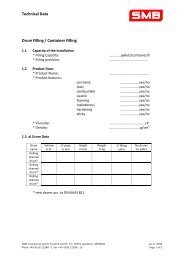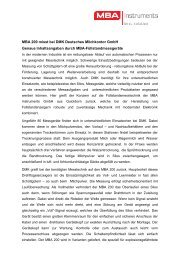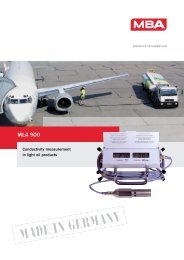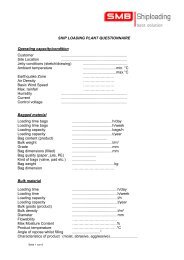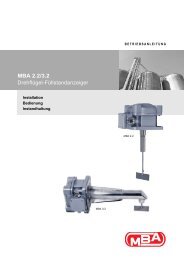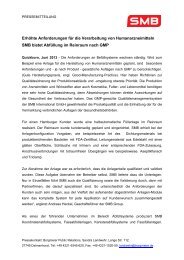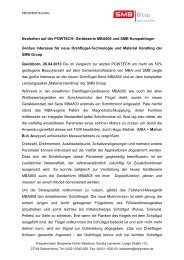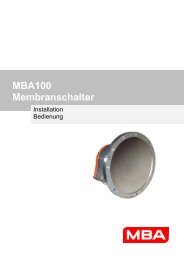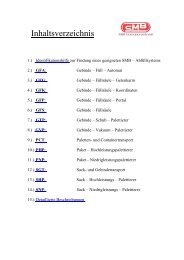MBA 200 Rotating Paddle - SMB Group
MBA 200 Rotating Paddle - SMB Group
MBA 200 Rotating Paddle - SMB Group
Create successful ePaper yourself
Turn your PDF publications into a flip-book with our unique Google optimized e-Paper software.
Bin-level Indicator <strong>MBA</strong> <strong>200</strong><br />
4 First Start-up<br />
4.1 Switching on<br />
WARNUNG: Health risk / Explosion hazard<br />
During operation, the unit head and the cable gland(s) must<br />
be correctly closed and sealed. Otherwise the specified<br />
type of protection and the specified explosion protection<br />
(option) is not guaranteed.<br />
4.2 Function test at first start-up<br />
4.2.1 Check the operative function<br />
After the first start-up, check the indicating function:<br />
1. Allow the paddle to rotate freely: check the »empty«<br />
indication.<br />
2. Stop the paddle by hand: check the »full« indication.<br />
4.2.2 Check for triggering by the bulk material<br />
Procedure<br />
While visually watching the bulk material level, fill and<br />
empty the bulk materials container up to the <strong>MBA</strong> unit,<br />
and check that the indicating function is correctly<br />
triggered. This test should be made several times.<br />
If the <strong>MBA</strong> unit does not correctly indicate the level<br />
status: Check the options for mechanical adaptation (see<br />
below) and carry them out if necessary.<br />
If the type of bulk material has been changed:<br />
Do this test/adaptation again.<br />
Possible ways of adapting the unit<br />
● Spring tension (see figure):<br />
– More sensitive setting (less tension), for light bulk<br />
material: Bring the spring to closer position.<br />
– Less sensitive setting (more tension), for heavy bulk<br />
material: Bring the spring to a more distant position.<br />
● <strong>Paddle</strong> size:<br />
– To make it more sensitive (for lighter bulk material):<br />
Install a bigger paddle.<br />
– To make it less sensitive: Install a smaller paddle.<br />
● Spring type: If required, install a stronger or weaker<br />
spring (3 different types available).<br />
5 Maintenance<br />
5.1 Recommended maintenance work<br />
Clean the moving external parts: Clean off deposits and<br />
dirt on paddle and shaft, using a (soft) scraper and/or a<br />
brush. Do not use force. Caution: Do not damage the<br />
shaft sealing. Do not allow bristles to get between the<br />
shaft and the shaft sealing.<br />
Inspect the parts subject to wear (highly recommended<br />
in case of abrasive bulk material): Make a visual<br />
inspection of the parts which protrude into the container<br />
(shaft, paddle, etc.). Pay special attention to the<br />
connecting parts (split-pins, etc.). Replace damaged or<br />
dubious parts.<br />
Clean the protective tube (only if the unit is equipped<br />
with an open protective tube): Clean the inside of the<br />
protective tube to make sure that the shaft can always<br />
freely rotate.<br />
Clean the distance tube (if existing – if required for<br />
explosion protection → page 7, § 3.3.4): Remove dust<br />
contamination from the distance tube.<br />
5.2 Preventive function check<br />
If the indicating function is seldom triggered during operation<br />
(e.g. if the level indicator is used as a safety switch):<br />
1. Inform the connected stations that a test will be carried<br />
out.<br />
2. Stop the paddle by hand / allow the paddle to rotate<br />
freely, and check the correct status indication.<br />
5.3 Safety information on opening<br />
WARNUNG: Health risk / Explosion hazard<br />
Before opening the unit head: switch-off the power<br />
supply and any connected signal voltage at an external<br />
point. (Note: the level indication is thereby disabled.)<br />
Only open the housing when you are absolutely sure<br />
that there is no possible danger.<br />
WARNUNG: High voltage inside the unit head (type 230)<br />
In the type 230 unit head, there are always contacts with an<br />
output of 230 and 115 V, even if the unit is powered with a<br />
lower voltage (→ page 9, § 3.4.6).<br />
Observe this information when operating the unit with<br />
open unit head for service purposes. Take care. Give a<br />
warning to other persons.<br />
Severe dirtiness inside the unit head can affect the proper<br />
functioning of the unit.<br />
Protect the inside of the unit head from getting dirty.<br />
5.4 Removing the unit head (repair note)<br />
The unit head can easily be separated from the process<br />
connection, without opening the process connection:<br />
1. If the unit head is to be removed completely, disconnect<br />
the electric cables first.<br />
2. Loosen the fixing screw on the underside of the unit head<br />
for approximately 3 mm (3 … 4 turns).<br />
3. Carefully pull the unit head from the process connection<br />
(along the direction of the shaft). This requires some<br />
strength, due to adhesion and friction of the sealing: use<br />
skilful power, but no brutal force; protect yourself against<br />
tumbling and falling in the case that the unit head goes<br />
suddenly free.<br />
Re-assembly is made in reverse order.<br />
10<br />
<strong>MBA</strong> <strong>200</strong> · Operating Instructions 8011417 V 2.2 · © <strong>MBA</strong> Instruments GmbH Germany



